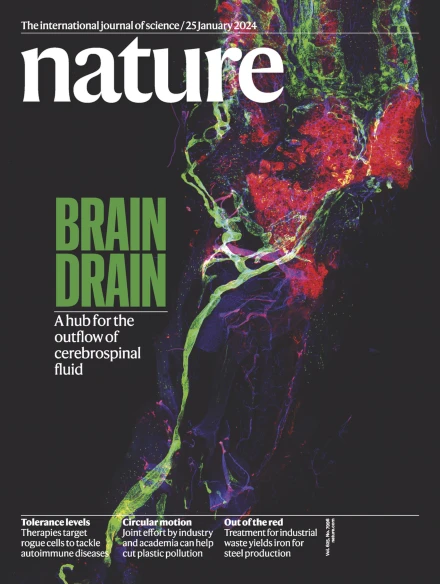原生核小体内在地编码基因组组织原理
IF 50.5
1区 综合性期刊
Q1 MULTIDISCIPLINARY SCIENCES
引用次数: 0
摘要
真核生物基因组被包裹在组蛋白核心周围147个碱基对的核小体中,并被组织成常染色质和异染色质,分别对应于a和B室1,2。在这里,我们研究了单个核小体是否包含足够的信息,例如,在它们的生物物理特性中,使三维基因组组织进入隔室。我们纯化了原生单核小体,使其具有高的单分散性,并使用生理浓度的多胺来测定其可凝聚性。已知划分为A区室的染色体区域具有低可聚性,而划分为B区室的染色体区域具有高可聚性。使用可冷凝性作为唯一输入的染色质聚合物模拟,没有任何反式因子,再现了A/B区室。可冷凝性也与基因表达强烈反相关,特别是在启动子附近和以细胞类型依赖的方式。因此,单核小体具有与基因开启或关闭相关的生物物理特性。与遗传和表观遗传特征的比较表明,核小体可凝聚性是一种涌现的特性,提供了一个自然轴,在其上投射高维细胞染色质状态。利用各种浓缩剂或组蛋白修饰和突变的分析表明,编码到核小体中的基因组组织原理本质上大多是静电的。由于敲除或抑制鸟氨酸脱羧酶,小鼠T细胞中的多胺缺失导致超极化可压缩性,这表明当细胞不能依靠多胺将核小体的生物物理特性转化为三维基因组组织时,它们会加强可压缩性对比,这可能解释了多胺缺失所观察到的功能障碍3,4,5。本文章由计算机程序翻译,如有差异,请以英文原文为准。


Native nucleosomes intrinsically encode genome organization principles
The eukaryotic genome is packed into nucleosomes of 147 base pairs around a histone core and is organized into euchromatin and heterochromatin, corresponding to the A and B compartments, respectively1,2. Here we investigated whether individual nucleosomes contain sufficient information for 3D genomic organization into compartments, for example, in their biophysical properties. We purified native mononucleosomes to high monodispersity and used physiological concentrations of polyamines to determine their condensability. The chromosomal regions known to partition into A compartments have low condensability and those for B compartments have high condensability. Chromatin polymer simulations using condensability as the only input, without any trans factors, reproduced the A/B compartments. Condensability is also strongly anticorrelated with gene expression, particularly near the promoters and in a cell type-dependent manner. Therefore, mononucleosomes have biophysical properties associated with genes being on or off. Comparisons with genetic and epigenetic features indicate that nucleosome condensability is an emergent property, providing a natural axis on which to project the high-dimensional cellular chromatin state. Analysis using various condensing agents or histone modifications and mutations indicates that the genome organization principle encoded into nucleosomes is mostly electrostatic in nature. Polyamine depletion in mouse T cells, resulting from either knocking out or inhibiting ornithine decarboxylase, results in hyperpolarized condensability, indicating that when cells cannot rely on polyamines to translate the biophysical properties of nucleosomes to 3D genome organization, they accentuate condensability contrast, which may explain the dysfunction observed with polyamine deficiency3–5. A technique called condense-seq has been developed to measure nucleosome condensability and used to show that mononucleosomes contain sufficient information to condense into large-scale compartments without requiring any external factors.
求助全文
通过发布文献求助,成功后即可免费获取论文全文。
去求助
来源期刊

Nature
综合性期刊-综合性期刊
CiteScore
90.00
自引率
1.20%
发文量
3652
审稿时长
3 months
期刊介绍:
Nature is a prestigious international journal that publishes peer-reviewed research in various scientific and technological fields. The selection of articles is based on criteria such as originality, importance, interdisciplinary relevance, timeliness, accessibility, elegance, and surprising conclusions. In addition to showcasing significant scientific advances, Nature delivers rapid, authoritative, insightful news, and interpretation of current and upcoming trends impacting science, scientists, and the broader public. The journal serves a dual purpose: firstly, to promptly share noteworthy scientific advances and foster discussions among scientists, and secondly, to ensure the swift dissemination of scientific results globally, emphasizing their significance for knowledge, culture, and daily life.
 求助内容:
求助内容: 应助结果提醒方式:
应助结果提醒方式:


